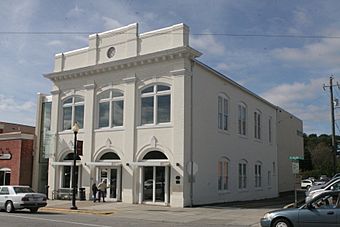Apex Town Hall (historic) facts for kids
Quick facts for kids |
|
|
Apex City Hall
|
|

The Historic Apex Town Hall now houses the Halle Cultural Arts Center
|
|
| Location | Apex, North Carolina |
|---|---|
| Built | 1912 |
| NRHP reference No. | 85003077 |
| Added to NRHP | December 5, 1985 |
The Apex Town Hall, also known as Apex City Hall, is a historic building in downtown Apex, North Carolina. It is located at 237 N Salem Street within the historic area. This important building was constructed in 1912. It was built after a big fire on June 12, 1911, destroyed many buildings downtown, including the previous town hall.
The ground floor of the new town hall was once a busy farmer's market. Farmers sold fresh meat, vegetables, and even chickens there. The building also had two jail cells. Upstairs, there was a large auditorium with a stage for performances, along with dressing rooms and the mayor's office. The building was kept warm by wood stoves and lit by oil lamps.
The auditorium was a popular spot for community events. People came to watch silent movies, listen to educational talks called Chautauquas, and enjoy plays.
In 1927, the Apex Volunteer Fire Department was created. Their first home was right in the town hall! They parked their fire engine in a special bay on the left side of the building. The fire department stayed there until 1957. Later, in 1958, they moved into their own building across the street.
For a while, there was another building attached to the back of the town hall. This was used by the public works department. However, it was later removed to create more parking spaces. The DMV also had an office in the building for some time.
The town hall's main offices moved out of the building in 1978. They relocated to 205 Saunders Street. After the move, the old building was in poor condition. But the town decided to fix it up! It was then used by the Apex Parks and Recreation department until 2007.
Halle Cultural Arts Center
Since January 10, 2008, the historic building has been home to the Halle Cultural Arts Center. This center is a vibrant place for art and performances. Downstairs, you can explore an art gallery. Upstairs, there is a performance hall that still has the original flooring from the old auditorium.
During the renovations, some new parts were added to the building. These include a beautiful glass-enclosed staircase and an elevator on the south side. An extension was also built on the back of the building.
The excellent work done on the renovations has been recognized with awards. These include the AIA-Triangle Merit Award and the 2008 Anthemion Award from Capital Area Preservation.




